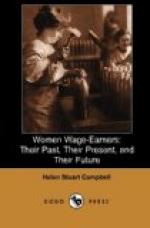Cotton would seem, from the beginning of manufacturing interests, to have monopolized New England; but other industries had been very early suggested. In May, 1640, the General Court of Massachusetts made an order for the encouragement by bounties of the manufacture of linen and woollen as well as cotton. In 1638 a company of Yorkshiremen came over and settled in Rowley, Mass., where they built the first fulling-mill in the United States. Fustians and the ordinary homespun cloth were woven; but few women were employed, the work being far heavier than the weaving of cotton. It was hoped that broadcloths as good as those imported could be made; but American wool proved less susceptible of high finish, though of better wearing quality than the English. Various grades of cloth, with shawls, were manufactured; but the growth of the industry was slow, and constantly hampered by heavy duties and much interference. In 1770 the entire graduating class at Harvard College were dressed in black broadcloth made in this country, the weaving of which had been done in families. Yarn was sent to these after the wool had been made ready in the mills, and the census of the United States for 1810 gives the number of yards woven in this way as 9,528,266.
What proportion of women were engaged we have no means of knowing; but the census of 1860 shows that New England had 65 per cent of the total number then at work. The cotton manufacture had but 38 per cent of males as against 62 per cent of females; while in woollen, males were 60 per cent. In New England 10,743 women were in woollen-mills; in the Middle States, 4,540; and in the South, 689. For the West no returns are given. Many more would be included in the Southern returns were it not that most of the weaving is still a home industry, this resulting from the sparseness and scattered nature of the population.
Knitting formed one of the earliest means of earning for women, the demand for hose of every description being beyond the power of the family to supply. Knitting-machines of various orders were in use on the Continent, and had been brought into England; but any attempt to employ them here was for a long time unsuccessful. Yarn was spun especially for this purpose, usually with a double thread, and in the year 1698 Martha’s Vineyard exported 9,000 pairs. The German and English settlers of Pennsylvania brought many handknitting machines with them, and were rivals of New England; but Virginia led, and the census of 1810 credits her with over half of the hand-knit pairs exported, Connecticut coming next. In Pennsylvania the women earned half a crown a pair for the long hose, and this in the opening of the eighteenth century; and the State still retains it as a household industry. The percentage for the United States of women engaged in it by the last census is 61,100.
The early stages of the industry employed very few women, the processes involving too heavy labor; and out of 159 workers in the first mills, only eight were women, these being employed in carding and fulling. According to our last census, 10,743 are employed in New England mills alone; but the proportion remains far below that of the cotton-mills, and at many points in the South and remote territories it is still a household industry in which all share.




